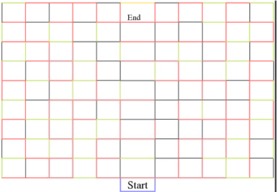 |
|
||||||||














EDUC 475/698A
|
|||||||||||||||||||||||
THE ECONOMISTBy Ramona But |
 |
| Instructional
Objective | Learners & Context |
Object of Game | Game
Materials | |
|
Instructional ObjectiveThe learners will become familiar with the basic concepts of economics. Most of these concepts will be related to the United States’ economy. The learners will be able to identify a variety of macro-economic and micro-economic factors. |
|
Learners & Context of UseThe game is designed for learners ages 15 and up, who are interested in economics. The game is most helpful for high school or undergraduate students who want to learn more or major in economics. The game can be used in any circumstances, including a classroom. To play the game, the learners only need a flat surface on which to put the game board. |
|
Object of the GameCreate the quickest path, by answering questions about economics, and be the first to get to the finish line. |
|
Game Materials
The game board has a rectangular shape and is divided in 99 rectangles. The width and length of each rectangle represents paths that the learner can follow to get to the finish line. Throughout the path, there are different colors that have different meanings. The 4 figurines represent soldiers that have different colors. The two stacks of cards include questions from macro and micro economics. Each card includes one question. |
|
Time RequiredThe game is for 2 to 4 players and will play for approximately thirty minutes to an hour. If a player chooses the quickest path and answers correct thirteen questions in a row, he can finish the game in less than thirty minutes. |
|
The RulesGame Play:
|
|
Design ProcessAt first, I was thinking about creating a game similar to Monopoly, but then I realized that my game would be too common. I wanted to create something different than anything else I saw before. I started by drawing different shapes for the game board such as circles, hexagons, triangles, etc. I ended up choosing a rectangular shape for my game board, which I divided into smaller rectangles. At first I wanted the player to go from one rectangle to another to get to the finish line, but then I thought that my game would be too ordinary. I checked the websites posted on WebCT, and I saw there few games similar to the game I wanted to create. Therefore, I decided to choose the width and length of the rectangles to be the paths to the finish line. Then, I realized that all the players will choose the same path to get to the finish line, and that would be the straight line from Start to Finish. Therefore, I had to come up with something else, and I decided to have different colors along the paths. This way, the players could choose different paths to get to the finish line. I decided to choose three colors: green, red, and black; each color enforcing different rules. By choosing different colors for the widths and lengths of the rectangles, I created a more interesting game. Moreover, the game would last longer. Before I decide on the shape of the game board and the rules of the game, I new that the topic of the game will be economics. I wanted teenagers to learn the basic concepts of economics, especially about the United States’ economy. I also wanted to create an interactive game that would include more than economics. This is the reason why I created the different colors for the game board, and I forced the teenagers to use their creativity; before they answer any question, the players have to decide which is the quickest path for them to get first to the finish line. Before I decided to put anything on paper, I created a draft of the game board and I brought it to class. I showed it to my classmates and I explained them the rules of the game, and they seemed to like it. In addition, the teacher gave me a positive feedback, and then I knew that I was on the right track. The lesson I learned from this game board that I will carry to my next game design project, is that in order to create something you need to have patience. Moreover, I learned that I have to put all my ideas on paper, and then decide which ones are the best. |
|
ReferencesEhrenberg, Ronald G, and Robert S. Smith. Modern Labor Economics: Theory and Public Policy. New York: Addison Wesley, 2003. McClave, James T, P. George Benson, and Terry Sincich. Statistics fro Business and Economics. New Jersey: Pearson Prentice Hall, 2005. |
|
| College of Education University of Maryland Benjamin Building College Park, MD 20742 http://www.edtechpolicy.org dpruitt@umd.edu |
 |
Copyright
© 2004 College of Education University of Maryland, College Park http://www.education.umd.edu |

